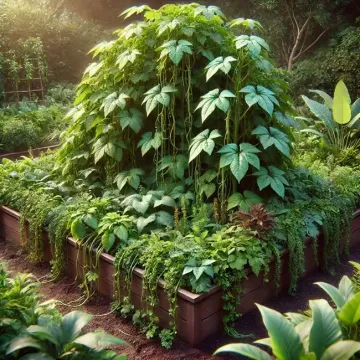Yams, a staple crop in many tropical regions, are large, starchy tubers often confused with sweet potatoes. Unlike sweet potatoes, yams belong to the genus Dioscorea and can grow much larger and are more starchy and drier in texture. Yams are known for their rich history and cultural significance, particularly in Africa, Asia, and the Caribbean. Growing yams in the home garden requires patience, space, and a warm climate, but it can be a rewarding experience if the conditions are right.
History of Yams
Yams have been cultivated for over 10,000 years, primarily in West Africa and Southeast Asia. They played a significant role in the diet and agriculture of ancient civilizations. In many African cultures, yams are not just food but are also deeply embedded in social and cultural practices, symbolizing wealth and prosperity. The annual Yam Festival in parts of West Africa is a celebration of the yam harvest and a testament to its importance in local traditions.
Types of Yams
There are several species of yams, but the most common ones for home gardening are:
- Dioscorea alata (Purple Yam): Known for its vibrant purple flesh, this variety is often used in desserts and has a slightly sweet flavor.
- Dioscorea rotundata (White Yam): Popular in West Africa, this yam has a white flesh and a more neutral flavor, often used in savory dishes.
- Dioscorea cayenensis (Yellow Yam): This variety has a yellow flesh and a slightly sweeter taste than white yam.
Each of these varieties can be grown in the home garden, provided the right conditions are met.
Growing Conditions for Yams
Yams thrive in warm, tropical climates. If you live in a cooler region, growing yams in a greenhouse or container may be necessary. Here are the ideal conditions for yam cultivation:
- Climate: Yams need a long, warm growing season of at least 8-10 months. They thrive in temperatures between 77°F and 95°F (25°C to 35°C).
- Soil: Yams prefer well-drained, loamy soil that is rich in organic matter. The soil should be loose enough to allow the tubers to expand. A slightly acidic to neutral pH (5.5 to 6.5) is ideal.
- Watering: Yams require consistent moisture, especially during the growing season. However, they do not tolerate waterlogged soil, so proper drainage is crucial.
- Sunlight: Full sun is best for yam plants, but they can tolerate partial shade. Aim for at least 6-8 hours of direct sunlight per day.
- Support: Since yams are a vining plant, they require a sturdy trellis or support system to help the vines climb and spread.
Planting Yams
Yams are typically grown from "yam setts," which are pieces of the tuber with at least one sprouting eye. Here’s how to plant yams in your home garden:
- Prepare the Soil: Loosen the soil to a depth of at least 12-18 inches (30-45 cm) and mix in plenty of compost or well-rotted manure.
- Cut and Cure the Setts: Cut yam tubers into pieces, ensuring each piece has at least one eye. Let the cut pieces dry for a few days to prevent rotting.
- Planting: Plant the setts 4-6 inches (10-15 cm) deep, with the eye facing upwards. Space the plants about 12 inches (30 cm) apart, with rows spaced 3-4 feet (90-120 cm) apart to allow for vine growth.
- Mulching: Mulch around the plants to retain moisture and suppress weeds.
Caring for Yams
Yams are relatively low-maintenance once established. Regular care includes:
- Weeding: Keep the area around the plants weed-free to prevent competition for nutrients.
- Fertilizing: Yams benefit from a balanced fertilizer, particularly one rich in potassium, which encourages tuber growth. Organic options like compost and bone meal can also be used.
- Watering: Water regularly, especially during dry spells, but avoid overwatering, as yams are prone to rot in soggy soil.
- Pest and Disease Control: Yams are generally resilient, but they can be affected by pests like yam beetles and nematodes, as well as fungal diseases like anthracnose. Organic pest control methods, crop rotation, and proper spacing can help prevent issues.
Harvesting Yams
Yams take between 8 to 10 months to mature, depending on the variety and growing conditions. The best time to harvest yams is when the foliage begins to yellow and die back, typically in late fall or early winter. Here’s how to harvest your yams:
- Digging Up the Tubers: Carefully dig around the base of the plant with a garden fork, being cautious not to damage the tubers.
- Curing: After harvesting, cure the yams by placing them in a warm, dry, and well-ventilated area for about 1 to 2 weeks. This helps toughen the skin and improve storage quality.
- Storage: Store cured yams in a cool, dark, and dry place. Properly stored yams can last for several months.
Culinary Uses of Yams
Yams are incredibly versatile in the kitchen. They can be boiled, roasted, fried, or mashed. In West African cuisine, yams are often pounded into a dough-like consistency to make fufu. In Caribbean dishes, they are commonly used in soups and stews. Purple yams are popular in Southeast Asian desserts, often incorporated into cakes, ice creams, and other sweet treats.
Health Benefits of Yams
Yams are not only delicious but also nutritious. They are rich in vitamins C and B6, potassium, and dietary fiber. Yams are also known for their anti-inflammatory properties and are a good source of antioxidants. Their high fiber content makes them beneficial for digestive health, while the complex carbohydrates in yams provide a steady source of energy.
Growing yams in the home garden can be a rewarding endeavor, especially for gardeners in warm climates. With the right care and attention, yams can provide a bountiful harvest of nutritious and versatile tubers. Whether you’re looking to expand your vegetable garden or explore new culinary possibilities, yams are an excellent addition to consider.

